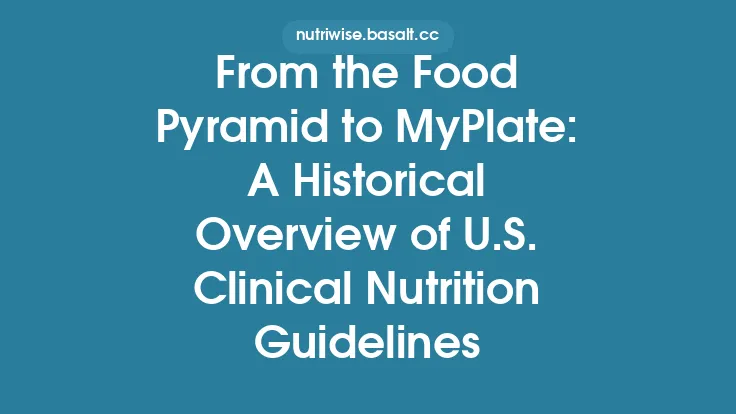Micronutrients—vitamins and minerals that the body needs in relatively small amounts—are the silent architects of health. They support everything from enzyme function and hormone synthesis to immune defense and DNA repair. While macronutrients (carbohydrates, proteins, and fats) provide the energy and building blocks for growth, micronutrients fine‑tune the physiological machinery that keeps those processes running smoothly. Because the body cannot store most vitamins and only stores limited amounts of minerals, a consistent intake of micronutrient‑rich foods is essential for maintaining optimal health throughout the lifespan.
Understanding Micronutrients: Vitamins and Minerals
Vitamins are organic compounds that act primarily as co‑enzymes or antioxidants. They are classified as water‑soluble (B‑complex vitamins and vitamin C) or fat‑soluble (vitamins A, D, E, K). Water‑soluble vitamins are generally excreted when intake exceeds needs, whereas fat‑soluble vitamins can accumulate in body tissues and, in excess, may become toxic.
Minerals are inorganic elements that serve structural, regulatory, and catalytic roles. They are divided into macrominerals (calcium, phosphorus, magnesium, sodium, potassium, chloride) required in gram quantities, and trace minerals (iron, zinc, copper, selenium, iodine, manganese, chromium, molybdenum) needed in milligram or microgram amounts.
Each micronutrient has a defined Recommended Dietary Allowance (RDA) or Adequate Intake (AI) that reflects the average daily intake sufficient to meet the needs of nearly all healthy individuals. For example, the RDA for vitamin C for adult women is 75 mg/day, while adult men require 90 mg/day. Calcium’s RDA for most adults is 1,000 mg/day, increasing to 1,200 mg/day for women over 50 and men over 70.
The Six Major Food Groups and Their Micronutrient Contributions
The dietary guidelines that organize foods into groups provide a useful framework for ensuring a broad spectrum of micronutrients. Below is an overview of the typical micronutrient profile associated with each group, emphasizing the diversity of nutrients rather than ranking “top” sources.
1. Fruits
- Vitamin C: Citrus fruits, kiwi, strawberries, and papaya are rich sources.
- Vitamin A (as β‑carotene): Mangoes, cantaloupe, and apricots contribute provitamin A.
- Potassium: Bananas, oranges, and melons help meet daily potassium needs.
- Folate: Avocado, oranges, and papaya provide folate, essential for DNA synthesis.
2. Vegetables
- Leafy Greens (e.g., kale, spinach, collard greens): High in vitamin K, folate, magnesium, and iron (non‑heme).
- Cruciferous Vegetables (broccoli, Brussels sprouts, cauliflower): Supply vitamin C, vitamin K, and potassium.
- Root Vegetables (sweet potatoes, carrots, beets): Offer β‑carotene, potassium, and manganese.
- Allium Family (onion, garlic, leeks): Contain trace amounts of selenium and vitamin C.
3. Grains (Whole and Refined)
- B‑Complex Vitamins: Whole grains such as brown rice, quinoa, and oats retain thiamin (B1), riboflavin (B2), niacin (B3), and folate.
- Minerals: Whole grains are notable for magnesium, phosphorus, and selenium.
- Iron and Zinc: Enriched refined grains (e.g., fortified white bread) often have added iron and zinc to compensate for losses during processing.
4. Protein Foods
- Meat, Poultry, and Fish: Provide heme iron (highly bioavailable), zinc, selenium, vitamin B12, and vitamin D (especially fatty fish).
- Legumes (beans, lentils, peas): Supply folate, iron (non‑heme), magnesium, and potassium.
- Nuts and Seeds: Rich in vitamin E, magnesium, copper, and manganese.
- Eggs: Contain vitamin D, choline (a B‑vitamin‑like nutrient), and selenium.
5. Dairy and Dairy Alternatives
- Calcium: Milk, yogurt, and fortified plant milks are primary sources.
- Vitamin D: Fortified dairy provides vitamin D, enhancing calcium absorption.
- Phosphorus and Riboflavin: Naturally present in dairy; fortified alternatives often add riboflavin.
- Potassium: Yogurt and kefir contribute modest amounts.
6. Fats and Oils
- Vitamin E: Wheat germ oil, sunflower oil, and almonds are notable sources.
- Vitamin K2 (menaquinone): Fermented foods such as certain cheeses contain K2, which differs from the K1 found in leafy greens.
- Essential Fatty Acids (EPA/DHA): While not micronutrients per se, they support the absorption of fat‑soluble vitamins.
By incorporating a variety of foods from each group, the diet naturally supplies a comprehensive micronutrient portfolio without the need for isolated “super‑food” focus.
Bioavailability: How the Body Accesses Micronutrients
The mere presence of a micronutrient in food does not guarantee its absorption. Bioavailability is influenced by several factors:
- Chemical Form
- *Heme iron (from animal sources) is absorbed at rates of 15–35 %, whereas non‑heme iron* (from plants) is absorbed at 2–20 % and is more sensitive to dietary inhibitors.
- *β‑Carotene* is converted to retinol (vitamin A) with an efficiency of roughly 12 µg β‑carotene to 1 µg retinol in mixed diets.
- Presence of Enhancers
- Vitamin C markedly improves non‑heme iron absorption by reducing ferric (Fe³⁺) to ferrous (Fe²⁺) form.
- Dietary fat (≈5–10 g per meal) is required for optimal absorption of fat‑soluble vitamins A, D, E, and K.
- Lactose and certain peptides can enhance calcium absorption.
- Presence of Inhibitors
- Phytates (found in whole grains, legumes, nuts) bind minerals such as iron, zinc, and calcium, reducing their uptake. Soaking, sprouting, or fermenting can degrade phytates and improve mineral availability.
- Oxalates (present in spinach, rhubarb, beet greens) chelate calcium, limiting its absorption.
- Polyphenols (tannins in tea, coffee) can inhibit non‑heme iron absorption when consumed in large quantities with meals.
- Physiological Status
- The body up‑regulates absorption of certain nutrients when stores are low (e.g., increased iron absorption during deficiency) and down‑regulates when stores are sufficient (e.g., reduced calcium absorption with high serum calcium).
Understanding these dynamics helps in designing meals that maximize the usable fraction of each micronutrient.
The Role of Food Matrix and Processing
The *food matrix*—the physical and chemical environment surrounding nutrients—affects both stability and release during digestion.
- Heat Treatment: Cooking can destroy heat‑sensitive vitamins (e.g., vitamin C, thiamin) but also liberates others. For instance, cooking tomatoes increases lycopene bioavailability, while steaming carrots enhances β‑carotene release.
- Mechanical Processing: Grinding grains into flour reduces particle size, improving mineral accessibility but may also increase exposure to oxidation, diminishing vitamin E.
- Fermentation: Yogurt, kefir, and fermented soy products (tempeh, miso) not only add probiotic benefits but also increase bioavailability of B‑vitamins and certain minerals through microbial enzymatic activity.
- Fortification and Enrichment: Adding micronutrients to foods (e.g., iodine to salt, folic acid to flour) compensates for losses during processing and addresses population‑wide gaps.
Choosing appropriate preparation methods—such as brief steaming, quick sautéing, or raw consumption where feasible—helps preserve the micronutrient integrity of foods.
Common Micronutrient Gaps and How to Address Them
Epidemiological surveys consistently identify several micronutrients that many adults fall short of:
| Micronutrient | Typical Deficiency Indicators | Dietary Strategies |
|---|---|---|
| Vitamin D | Low serum 25‑hydroxyvitamin D (<20 ng/mL) | Include fatty fish (salmon, mackerel), fortified dairy/plant milks, and safe sun exposure; consider supplementation in high‑latitude regions. |
| Iron (especially for premenopausal women) | Low ferritin, anemia | Pair plant‑based iron sources with vitamin C‑rich foods; incorporate lean red meat or poultry a few times weekly; use iron‑enhanced cooking vessels (cast iron). |
| Calcium | Low bone mineral density | Emphasize dairy, fortified alternatives, leafy greens (collard, bok choy), and calcium‑set tofu. |
| Folate | Elevated homocysteine, neural‑tube defect risk in pregnancy | Consume legumes, leafy greens, citrus fruits, and fortified grains. |
| Vitamin B12 (vegans) | Neurological symptoms, macrocytic anemia | Include fortified plant milks, nutritional yeast, or consider a B12 supplement. |
| Magnesium | Muscle cramps, arrhythmias | Nuts, seeds, whole grains, and legumes are good sources. |
| Iodine | Goiter, hypothyroidism | Use iodized salt, seaweed (in moderation), and dairy. |
Targeted dietary adjustments—such as adding a vitamin C source to iron‑rich meals or selecting calcium‑fortified plant milks—can close these gaps without resorting to excessive supplementation.
Special Considerations: Life Stages, Health Conditions, and Dietary Patterns
- Pregnancy & Lactation: Increased needs for folate (600 µg/day), iron (27 mg/day), calcium (1,000 mg/day), and vitamin D (600 IU/day). Prenatal vitamins are often recommended to ensure adequacy.
- Older Adults: Reduced gastric acid secretion impairs vitamin B12 absorption; calcium and vitamin D needs rise to support bone health.
- Athletes: Higher turnover of B‑vitamins and minerals like zinc and magnesium may necessitate slightly higher intakes.
- Vegetarian & Vegan Diets: Emphasis on plant‑based sources of iron, calcium, zinc, and vitamin B12, with attention to bioavailability enhancers (e.g., soaking beans, using fermented foods).
- Chronic Kidney Disease: Requires careful monitoring of potassium, phosphorus, and calcium intake to avoid complications.
- Food Allergies/Intolerances: Individuals avoiding dairy must seek alternative calcium and vitamin D sources; those with celiac disease need gluten‑free whole grains that still provide B‑vitamins and minerals.
Tailoring micronutrient intake to these contexts ensures that the universal goal of nutrient adequacy aligns with individual physiological demands.
Practical Strategies for Maximizing Micronutrient Intake
- Color Diversity: Aim to fill the plate with a spectrum of colors—red (tomatoes, red peppers), orange/yellow (carrots, mango), green (leafy vegetables, peas), purple/blue (berries, eggplant), and white/brown (whole grains, nuts). Different pigments often signal distinct phytonutrients and associated micronutrients.
- Balanced Meal Composition: Include at least one source of protein, one source of healthy fat, and one source of fiber in each meal to promote optimal absorption of both water‑ and fat‑soluble vitamins.
- Mindful Pairings: Combine iron‑rich plant foods with vitamin C sources (e.g., lentil soup with a squeeze of lemon) and pair fat‑soluble vitamin sources with modest amounts of healthy oil (e.g., sautéed kale with olive oil).
- Seasonal Rotation: While the article avoids a “seasonal superfood” focus, rotating produce throughout the year naturally broadens the micronutrient profile and reduces reliance on a narrow set of foods.
- Cooking Techniques: Use steaming or microwaving for delicate vegetables to preserve water‑soluble vitamins; employ quick stir‑frying or roasting for root vegetables to enhance carotenoid availability.
- Utilize the Whole Food: When possible, consume edible skins and seeds (e.g., apple skin, pumpkin seeds) as they often concentrate micronutrients.
- Hydration and Digestive Health: Adequate fluid intake and a healthy gut microbiome support the breakdown and absorption of micronutrients, especially those bound to fiber.
These strategies are adaptable to any dietary pattern—omnivorous, vegetarian, or vegan—and reinforce the principle that a varied, whole‑food‑based diet is the most reliable path to micronutrient sufficiency.
Monitoring and Assessing Micronutrient Status
Self‑assessment can be complemented by periodic laboratory testing, especially for nutrients prone to deficiency:
- Blood Tests: Serum 25‑hydroxyvitamin D, ferritin, hemoglobin, vitamin B12, folate, calcium, magnesium, and zinc levels.
- Urinary Tests: Iodine excretion (spot urine) provides a snapshot of iodine intake.
- Functional Markers: Bone density scans (DEXA) for calcium/vitamin D status; nerve conduction studies for B‑vitamin deficiencies.
When interpreting results, consider factors such as recent dietary changes, supplementation, medication interactions, and physiological states (e.g., pregnancy). Working with a qualified health professional ensures that any identified gaps are addressed safely and effectively.
Frequently Asked Questions
Q: Can I meet all my micronutrient needs from a plant‑based diet?
A: Yes, provided the diet includes a wide variety of legumes, whole grains, nuts, seeds, fruits, and vegetables, and incorporates fortified foods or supplements for nutrients like vitamin B12 and, in some cases, vitamin D and iodine.
Q: How much cooking is too much for preserving vitamins?
A: Prolonged, high‑heat cooking (e.g., boiling for >30 minutes) can cause significant losses of water‑soluble vitamins. Short, gentle methods (steaming, microwaving, quick sauté) retain most nutrients while still improving digestibility.
Q: Are supplements necessary if I eat a balanced diet?
A: For most individuals with a diverse diet, supplements are not required. However, specific life stages (pregnancy, older age) or restricted diets (veganism, medical conditions) may warrant targeted supplementation.
Q: Does organic produce contain more micronutrients?
A: Research shows modest differences, often dependent on soil quality and crop variety rather than the organic label alone. The key factor is freshness and variety, not certification status.
Concluding Thoughts
Micronutrient adequacy is less about hunting for isolated “super‑foods” and more about embracing the full spectrum of foods that each food group offers. By understanding the roles of vitamins and minerals, recognizing how the body extracts them, and applying practical, evidence‑based strategies—colorful plates, thoughtful pairings, appropriate cooking, and periodic monitoring—anyone can build a resilient nutritional foundation that supports health today and into the future. The ultimate guide, therefore, is not a checklist of singular items but a holistic approach that celebrates diversity, balance, and the science behind how we nourish our bodies at the microscopic level.





